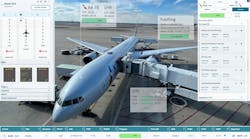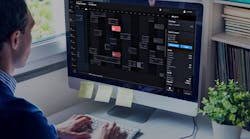Smart watches, smart glasses and other wearable computing devices will be part of the airport of the future, according to the latest findings from SITA Lab.
“Wearable devices like Google Glass offer new opportunities to mobilize staff, keeping their hands free, while keeping them connected … ,” said Jim Peters, SITA’s chief technology officer at the 2013 Aviation ICT Forum. “Interaction can be via video analysis of what a staff member is looking at, like a boarding pass or bag tag, or voice recognition, or a combination of both.”
While much of the SITA’s immediate research centered on terminal personnel and, in particular, an interesting trial using Google Glass that the IT company partnered with Virgin Atlantic on earlier this year, it’s also easy to see the potential for ramp agents.
“Aircraft turnaround can also benefit from the strong notification capabilities of wearable technologies,” says the report. “It is a critical activity comprising of numerous time-sensitive and event-driven tasks. The dispatch officer can be kept fully informed and up-to-date on progress without being tied to a desk.”
Stephane Cheikh, innovation manager for SITA Lab, also recently outlined how wearable tech could become part of the tarmac.
- Smart glasses linked to an airport management system via WiFi or mobile phone could provide ramp agents with their next task and all the background needed to complete the job.
- For troublesome equipment, the smart glasses could take a photo and forward on to a mechanic for a live video.
- No need to fill out paperwork since all the information could effortlessly transmitted back to the main office.
- Using augmented reality, ramp agents could access instructions on how to perform their tasks.
- Information on parts could be scanned and checked against inventory with an order placed with just a tap or voice command.
“The advent of wearable devices – with Google glass and Apple’s iWatch probably the most high profile examples – seems to be generating a lot of interest and some of the technology-watching analysts have tipped the whole sector for major growth,” says Dr. Gareth Evans, a European-based contributor of Ground Support Worldwide.
Credit Suisse, for example, predicts that the market for wearable technology will increase tenfold to as much as $50 billion over the next three to five years.
“On the plus side, SITA seems to have found many opportunities for check-in and reservations systems, not least allowing staff to maintain human interactions while calling up information,” Evans adds. “On the minus side, they also highlighted some difficulties with speed and battery life. All of this is to some extent inevitable, of course, given the early nature of the technology.”
SITA STUDY
Technology observers are touting wearable computing as the next big thing that could re-define how we use and interact with information.
“What is driving the phenomenal growth is not just smarter gadgets, but their ability to connect to other devices, such as smartphones and iPads, and the wireless Internet,” says the study. “It is another part of the long-predicted ‘Internet of Things’ in which everyday objects are connected enabling them to communicate and transfer data. As such they will also be a contributor to big data.”
A less-developed wearable market until very recently has been smart headgear. Google grabbed the headlines in early 2013 with the launch of a head-mounted display device called Google Glass to a select group of users.
SITA Lab was one of a few selected developers to receive both the Google Glass and Vuzix M100 devices before their public launch, in order to evaluate them. It -f
According to SITA, there are a number of advantages expected from wearable technologies in general and smart headsets in particular:
- Hands-free computing: This is of immediate benefit to anyone who performs physical tasks using both hands and needs access to information at the same time.
- Multitasking: It is not necessary to stop what you are doing to use the device while there can be constant interaction available between the device and user with no need to turn the device on or off.
- Information that’s ‘pushed.’ Context-specific information that doesn't have to be
- explicitly ‘pulled’ by the user. It means many of tasks that today use a tablet or smartphone could be simplified by wearable devices.
SWIFT BOARDING
As part of its testing, SITA Lab developed an application called SWIFT Boarding using the smart headgear’s built-in camera as a scanner and the heads-up display. The aim was to allow agents in the boarding area to securely scan and verify both a boarding pass and passport simultaneously wearing smart glasses. Both documents are held side by side while the app matches the two to ensure they belong to the same person.
Similarly, the team at SITA Lab found that smart glasses can be used to scan bag tags to retrieve mislaid bag information from WorldTracer, the airline industry database for finding misplaced baggage, or even phone the owner of the bag.
As a concept, SITA deemed the test a qualified success. Yes, travel documents and loyalty cards could be scanned by the smart glasses. But the devices are not fast enough yet to be able to meet the high speed passenger processing requirements needed at airports. Matching the documents takes longer than the industry’s one-second benchmark making it unviable as an alternative to existing systems, until more powerful smart glasses are developed.
“Our research has shown that for any type of use in the air transport industry the technology needs to be more robust to avoid breakage and the cost will have to come down,” Peters says.
The camera quality will also need to be enhanced. Currently it requires near perfect light conditions within the airport for scanning documents to be successful. Other areas to be addressed include bandwidth for widespread use, battery life and of course the cultural and social issues both for passengers and employees.
“It is no major surprise that our research into this developing technology shows that there are issues to address,” Peters adds. “This is inevitable with any new technology.
In fact, many of these same issues were identified by SITA Lab in the early days of the smartphone and the expectation is that they will disappear as new devices are released over the next 12-18 months. When that happens the potential that wearable computing promises may lead to new and innovative uses by the air transport industry.



